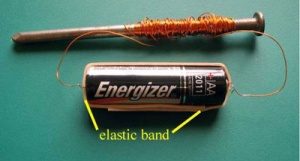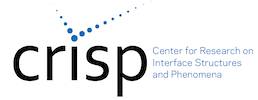Our kits are currently being reviewed and updated by a team of collaborative, innovative and interdisciplinary educators who wish to enhance the educational opportunities for students. These dedicated teachers are members of CRISP Collaborative Science for All (CCSA) as well as local educators.
Click to see the SCSU CRISP Module Template used by CCSA for improving and updating the CRISP demos and kits. Each kit page offers a CRISP developed teacher module and CRISP aligned standards (both NGSS and CCSS)
Kit Request form

An electromagnet is a type of magnet in which a magnetic field is produced by an electric current. Electromagnets consist of closely spaced coils of wire that create the magnetic field. When connected to a DC voltage or current source, the electromagnet becomes energized, creating a magnetic field just like a permanent magnet. DC electromagnets are principally used to pick up or hold objects.
Created by CRISP
Subject(s):
Electricity, Magnetism
Objectives:
Students will understand the relationship between current and magnetism.
Materials in this kit:
- 1 Battery (D)
- 1 Battery holder
- 1 Battery switch
- 2 Banana wires with alligator clip
- ~ 2 ft Black Coated Wire
- 1 Small square mesh wire (metal)
- 1 Small square mesh wire (Nylon)
- 1 Small magnetic compass
- Long metal screws
- Paper clips
- ~30 small washers
- Variety of Bolts, nuts, screw, nails and washer (MADE OF DIFFERENT MATERIALS)
Suggestions for the Teacher:
- Ask students to try this experiment by changing variables. Having the student choose their own variables will enable them to create their own experiment and hypothesis. (For example, there are several different screws included varying in length or thickness)
- If you decide to provide additional washers, make sure they are the same size and weight
Safety:
- Battery can overheat if wire is connected too long with little resistance. Please use the battery switch to prevent batteries from being drained
- Batteries should be disposed in a proper reciprocal.
Additional Resources:
Electromagnets Teacher Module
Electromagnet lab
Electromagnets student
Electromagnet background info
Electromagnet CRISP aligned Standards
STEM Careers:
Electrical Engineer
Materials Scientist
Researcher
Electrician
Engineer
Computer hardware Engineer
Electrical Engineering Technologists
Electrical and Electronic Engineering Technicians
Electro-Mechanical Technicians
Nanosystems Engineers
Standards:
PS2.B: Types of Interactions
Newton’s law of universal gravitation and Coulomb’s law provide the mathematical models to describe and predict the effects of gravitational and electrostatic forces between distant objects. (HS-PS2-4)
Forces at a distance are explained by fields (gravitational, electric, and magnetic) permeating space that can transfer energy through space. Magnets or electric currents cause magnetic fields; electric charges or changing magnetic fields cause electric fields.
PS3.A: Definitions of Energy
“Electrical energy” may mean energy stored in a battery or energy transmitted by electric currents.(secondary)
CC 3 - Cause and Effect
Empirical evidence is required to differentiate between cause and correlation and make claims about specific causes and effects.
SEP 4 - Planning and Carrying out Investigations
Plan and conduct an investigation individually and collaboratively to produce data to serve as the basis for evidence, and in the design: decide on types, how much, and accuracy of data needed to produce reliable measurements and consider limitations on the precision of the data (e.g., number of trials, cost, risk, time), and refine the design accordingly.
